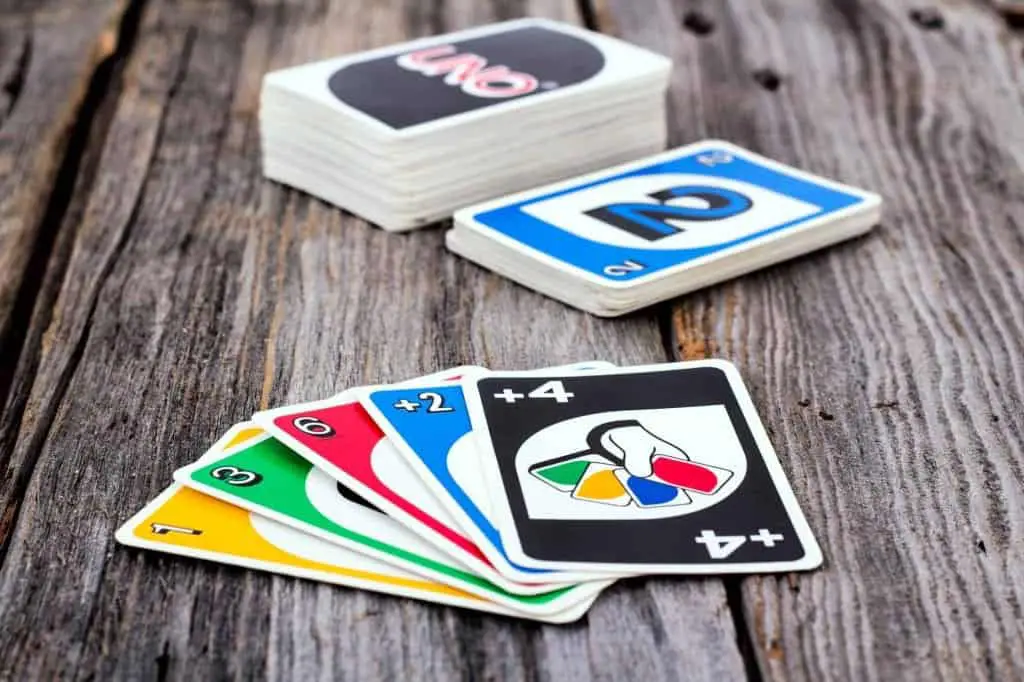Whether you’re packing light and traveling on the road, enjoying a lazy winter or summer stay at the cabin by the lake or simply in need of some new card games for kids to enjoy family fun around the dinner table, this helpful article is loaded with new and favorite card game ideas. Each of these fun card games is created or popular in some of our favorite countries, like Canada, Italy, and Switzerland. We’ve listed them by destination to inspire your travel dreaming while enjoying this round up of the best cards games from around the world.

Best card games from around the world

Australia – 500
While 500 originated in the US in the late 19th century, this is the national card game of Australia. Down under, 500 is played widely and continues to fuel long game nights – forcing players into deep concentration.
Most commonly played with 4 people in partnership, 500 can be enjoyed by groups of 2 to 6 people. If you’re an odd number, it’s considered an excellent game for 3 players.
500 is a trick-taking card game with an interesting bid process to kick things off. Each player considers the value of their hand and makes a bid for the number of tricks they think they can win with a particular suit. As Australians like a bit of a gamble, this might explain the game’s popularity.
The team or player who wins the bid, must win that number of tricks in the round. Each player has 10 cards and all you need to do to win the trick is put the highest card down. While the rules are easy to grasp, there are a few quirks to 500 which make it a challenging game geared towards adults.
In 500, all cards are in play, so there’s no luck involved in winning a round. Hence, you’ll find Australians inspecting their cards with great concentration, methodically devising a strategy for taking the most tricks. ~ Anywhere We Roam
Ages: 16 and up

England – Racing Demon
I grew up playing cards with my family and Racing Demon from England is one of our favourites. The game is fast-paced and can get VERY heated. I highly recommend playing on a sturdy table or on the floor and moving all delicate objects out of harm’s way
Racing Demon is more of an adults or older children’s game – younger children may well find themselves swamped in the excitement of the moment. This game is also known as Pounce or Nerts, and the rules remain the same for all versions.
This card game is a mixture of Solitaire and Speed and can played by multiple players at the same time. Three or more players are the ideal number, although it can be played with 2 with modified rules.
Each player starts with a full pack of cards and then begins a game of Solitaire, while trying to discard their cards onto the Aces which go into the middle and can be built upon by anyone.
And that’s where the fun starts. Whoever puts their card on the Ace pile first can keep it there, the other player must return their card to its place. You must build up the Aces in suits up to King- and then the Ace pile is dead.
The winner is either first to get rid of all their cards or you can score points, which can mean the winner isn’t necessarily the winner. It’s a brilliant game and a lot of fun, but be prepared to suddenly like your family or friends a little bit less during the heat of the card battle. ~ Wandering Bird
Ages: 15+

France – Belote
Belote is a French card game that can be played by two to four players. It uses 32 cards from a French-style deck and it’s a trick-taking type of card game. There are several versions of Belote, but the most common version features four players. The deck is never shuffled, but instead cut by the player next to the dealer. At least three cards must be cut and the first hand is done by the dealer’s partner and later on the winners from the previous game.
The goal of Belote is to get as many points as possible by making declarations of card sequences. Each card rank has a specific score value. For Jacks and Nines, their value depends on if the suit is trump or not.
Each player will get five cards to start with, and the remaining cards of the deck will have their face down, except the card on the top. Then it goes counter-clockwise where each player has to pass or accept the card that is face up. If every player passes, a new round will be made.
Each game takes about 30 – 45 minutes to play and it’s a card game that is suitable for older kids and adults since the rules can be a bit difficult to understand for younger kids. ~ The Swedish Nomad
If you’re looking for fun family game night ideas behind the card deck, check out this article about some of the best travel games for at home and abroad.
Ages: 15+
France – Mille Bornes
Mille Bornes, French for “a thousand miles,” is a French card game in which players race to reach 1,000 miles.
The game features game-specific cards that represent distance, hazard, remedy, or safety. Each player starts with six cards and the rest are set in a draw pile. On your turn, you draw a card, then play a card on the table in front of you. You’ll need a green light before you can go. Then you can begin putting down your distance (miles) cards in hopes of being the first to reach 1,000 miles exactly.
But en garde! Your opponent will be trying to slow you down with hazard cards such as red lights, speed limits, out of gas, flat tires, and accidents. Remedy these hazards by playing your own cards like end of limit, extra gasoline tank, spare tire, and repairs. If you are given a hazard, you cannot play any distance cards until you remedy your situation and get a green light again.
There are also four safety cards that will protect from hazards: Driving Ace, Fuel Tank, Puncture Proof, Right of Way. One of the most strategic elements of the game is the “coup-fourre” (French for “counter-thrust”). In this move, a player saves his safety card in his hand until the opponent plays the corresponding hazard card. Then you pounce and slam your safety card on the table. This move earns 300 points.
Mille Bornes works best with two to four players, but up to eight could work with players on teams – otherwise you won’t have enough mileage cards for anyone to win. It’s a fun game for the whole family. ~ The TV Traveler
Prefer board games? Check out this article on some of most popular travel-themed board games around the world.
Ages: 8+

Germany – Solitaire
Solitaire is a fun and challenging game that was invented in Germany in 1783. Popular around the world, Solitaire has various other names such as “Patience” in England and “Success” in France. This game indeed takes patience and one feels so much success after winning a round of this challenging game.
Solitaire is a great game for adults as well as kids, and it makes a fun family game. The best part of Solitaire is that you can play it alone, with one other person (“double solitaire”), or with a group. There are now over 150 types of Solitaire games.
The Standard Solitaire game is played by an individual with one standard deck of 52 cards.
The cards are laid out into seven piles, flipping only the top card up on each pile. All aces act as the foundation of each pile, and the object is to transfer all the cards onto the ace foundation of each suit.
A player must place cards in ascending order of the same suit on top of each ace, starting a foundation pile. Cards can also be moved onto the seven lower piles in descending order, mixing suits and alternative colors, and moving those onto the foundation piles when possible. When there are four complete ace piles in each suit, the game is won.
The game is fairly easy to learn but kids may need to do a practice round before playing an actual game. ~ Designs For Travel
Ages: 8+

Great Britain – Cribbage
Cribbage has been called ‘Britain’s national card game.’ It is the only one that you can legally play in English pubs (and clubs).
One of the more complicated (and challenging) of card games out there, cribbage can be easily recognized by its distinctive scoring board. This board is an elongated stretch with holes (called ‘streets’) where the score is kept with small pegs, called ‘spilikins.’
The objective? To make your way to 121 points before your competitors.
Usually played by adults (mainly since it’s a slightly tricky game), Cribbage is designed for two players but can be played by three or four. Usually the dealer (decided by cutting the deck to get the lowest card), deals six cards to each player; two of which the players give back to the dealer to form their ‘box’ or ‘crib’.
What then ensues is the first step – ‘Play’ – where players lay down one card at a time with the aim of being first to 15, matching cards for pairs or runs until reaching the magic number of 31. ‘Play’ then starts again from 0 and runs until all players are out of cards.
Next up is ‘Show’, where each player shows their full hand and counts up points for combinations of cards totaling fifteen, runs, pairs or a flush. This is where the ‘box’ comes in handy since that rounds’ dealer counts up their extra hand for more points. After ‘Show’ the dealer switches to the next player. And so the game of cribbage continues, until one player emerges victorious, nudging their peg into that coveted 121 ‘street’.
While the cards dealt to players are obviously by chance, Cribbage is – at its core – a game of strategy. Experienced players know how to calculate the odds, which cards to sacrifice to the ‘box’ and how to read other players based on their behaviour during the ‘Show’ round.
Whether it’s nursing a cold beer in a British pub or playing the game in the comfort of your home, Cribbage is one of the best card games around the world, perfect for the consummate card shark. ~ The Travel Scribes
Ages: 15+

Israel – Taki
Taki is a beloved card game played in Israel, developed by the game inventor Haim Shafir. The playing cards were designed specifically for this game by the artist Ari Ron. Most of the cards have a colored number between one and nine on them, in either yellow, red, blue, or green. Others are action cards that can benefit the player who uses them or help him/her sabotage other players.
The object of Taki is to discard all the cards you have in your hand. After shuffling the deck, each player gets eight cards. The rest of the deck is now the draw pile when the top card is turned over and becomes the first card of the discard pile.
Now, one by one, each player can discard a card only if it matches the previous card’s color, number. Or if it’s a certain action card like ‘switch color.’ If you don’t have anything to discard, you need to draw one card from the pile.
Other action cards like ‘plus two’ (forces the next player to draw two cards) and TAKI (allows you to discard multiple cards of the same color) are what makes this game fun and interesting.
Taki is a great game to play with all ages. It’s popular among both kids and adults. But it’s especially fun when the whole family gathers around and plays together. ~ My Path in the World
Ages: 7+

Italy – Briscola
Briscola is one of Italy’s most popular trick-taking card games. The object is to take cards for a high score. It’s played with two to six players using a specific Italian 40-card deck that is also used for the popular Scopa card game. Note: You can play Briscola using a standard international 52-card deck. Just remove the Jokers, eights, nines and tens.
The four- and six-player versions of the game are played as a partnership of two (or three) teams. Players are seated such that every player is adjacent to two opponents.
A deck of Italian cards consists of forty cards. They are divided into four decorative suits: coins (Denari in Italian, and sometimes suns or sunbursts), swords (Spade), cups (Coppe) and clubs (sometimes batons or Bastoni).
The values on the cards range numerically from one through seven. Plus three face cards in each suit: Knave, Knight and King. The cards have a rank and point value: Ace is 11 points; Three is 10 points; King is 4 points; Queen is 3 points; and Jack is 2 points.
After the deck is shuffled, each player is dealt three cards. The next card is placed face up on the playing surface. The remaining deck is placed face down, sometimes covering half of the up-turned card. This card is the Briscola, which represents the trump suit for the game.
The player to the right of the dealer leads the first hand (or trick) by playing one card face up on the playing surface. Each player subsequently plays a card in turn, until all players have played one card. The winner of that hand is determined as follows:
- if any briscola (trump) has been played, the player who played the highest valued trump wins
- if no briscole (trumps) have been played, the player who played the highest card of the lead suit wins
Unlike other trump card games, players are not required to follow suit. That is, to play the same suit as the lead player. They can play any of their cards.
Once the winner of a trick is determined, that player collects the played cards, and places them face down in a pile. Each player maintains his/her own pile. However, the four- and six-player versions may have one player collecting all tricks won by his partners. Then, each player draws a card from the remaining deck, starting with the player who won the trick, proceeding counter-clockwise.
The last card collected in the game should be the up-turned Briscola. After all cards have been played, players calculate the total point value of cards in their own piles. For multi-player games, partners combine their points. The player or team with the most points wins, or if each has 60, the game is a draw.
Ages: 10 years and up

Netherlands – Klaverjassen
Klaverjassen is a traditional Dutch trick-taking game that is extremely popular among older adults. Though with some patience, it can be taught to children too (my grandparents taught me and my brother at eight years old).
This game is played with two pairs sitting opposite each other who try to score as many points as possible in sixteen hands. Only 32 cards are used (7-10, Ace, and face cards of all four suits) and each player receives eight cards. Each card has a declining value, from Aces worth 11 points to zero points for nines, eights and sevens. The person sitting left of the dealer chooses trumps (rules vary on how to choose trumps, but for the sake of simplicity, I will stick to only one). Then that pair has to collect more than half of the available points. If they fail to do so, the competing team will receive all points.
The person sitting left of the dealer plays the first card and the other players have to follow suit. If you can’t follow suit, you have to play trumps, and you always have to beat the trumps that are already on the table. If you can’t follow suit nor play trumps, you can play any card you like. These are the Rotterdam rules, but again there are variations.
The highest trump wins the hand. If there are no trumps, the highest card wins, and that player starts the next trick. This is a very simple and short explanation of the game. Click here for a more detailed explanation. ~ Both Feet on the Road
Ages: 8+

Malta – Ħalliela
A visit to Malta island is almost guaranteed to encompass unique experiences, fine food, friendly locals, natural landscapes, and a good mix of cultures and languages. Originating on the island of Malta,Ħalliela, also known as Bella Donna, is a popular fishing-style card game.
It uses the international 52 card pack and is played counterclockwise by two players or four playing in teams. The suits comprise koppi, dinari, spadi, and maziwhere three-card hands are dealt, with an additional four to the table.
Each player takes a turn to play a card and when all the cards are played, three more cards are dealt. This continues until the deck is finished. Kings, Queens, and Jacks have no numerical value while red cards taken accumulate one point. There is a bonus of one point per black card taken and two per red card. The player with the highest number or points at the end is naturally the winner. This game is geared towards adults. It is not uncommon to see old men deep in concentration, playing this on the side of the street or in cafes throughout the island. ~ Rai of Light
Ages: 15+

Switzerland – Jass
A card game so wickedly popular, it has its own television show in Switzerland. Jass is a trick-taking card game with a specific card deck of 36 Jass cards with four suits. The Swiss German cards of suits of bells, shields, acorns and roses are highly decorative. The French suits are the more standard hearts, diamonds, spades and clubs.
All Swiss Jass games are played counterclockwise by two teams of two players each. Each player receives 9 cards which are played in tricks. As in most card games, each trick is won by the highest trump in it. Or if no trump is played, by the highest card of the suit. The winner of each trick begins the next round.
Jass is essentially a game of points which are scored for three features known as Stöck, Wiis, Stich. Respectively, “marriages, melds, tricks”. The Jack of the trump suit is called Puur and is the highest card in the game at 20 points. The last trick in a round of play is worth an additional 5 points.
The game is won by the player (or the team) who first reaches a previously agreed target score, most often 2500 points. Play ceases the moment one side reaches the target score. It’ss important to remember that scores accrue in order of; marriage (holding both the King and Queen of trumps), melds (suit sequence of three or more cards), and tricks. Read more about Jass here.
Ages: 12+

Russia – Mafia/Werewolves
This is one of our family’s favorite card games. Werewolves (of Millers Hollow) card game is based on the Russian game Mafia. This multi-player game can be played with as few as 6 and as many as 48 players. For larger groups, you’ll need to purchase an expansion pack. The game is suitable for ages 8 years and up.
Werewolves is a game of deception and manipulation. Players receive cards that divide them into two groups, the informed minority (werewolves) and the uninformed majority (villagers). The game is moderated by a narrator who does not participate in the game itself. They keep the flow of the party game going and maintain control over its structure.
At the start of the game, each player is secretly assigned a role affiliated with one of these teams. Those players who receive a werewolf card know the identity of each player. Villagers only know how many werewolves exist in total.
The game has two alternating phases. First, a night role, during which those with night killing powers (the werewolves) may covertly kill other players (whose eyes are closed). The second, a day role, is where surviving players debate the identities of players and vote to eliminate a suspect. This is where a player who may become targets of elimination deceives others about their identities. Or they plead for survival if unjustly accused.
The game continues until a faction achieves its ‘win condition’. For the village, this usually means eliminating the evil minority. While for the minority, this means reaching numerical parity with the village and eliminating any rivals and villagers.
Werewolves is an immersive party game. It’s perfect for larger groups and played outdoors around campfires, or indoors after a long day on the slopes or at the beach.
Age: 8 years and up
United Kingdom – Newmarket
Our family love playing ‘Newmarket’, a game named after a horse racecourse in the United Kingdom. The game is for two or more players and is best suited to older kids and adults.
Each player is allocated a set number of ‘lives’ with which they can place their bets. Our ‘lives’ have ranged from coins and sweets to ripped up pieces of paper – basically anything you can find on your travels.
To start, label four pieces of paper with one of the following – the Jack of Spades, the Queen of Hearts, the King of Clubs and the Ace of Diamonds. Place these papers centrally on the table then deal out the playing cards equally between the players. Before players look at their cards, each person must make two bets with their lives – one bet on one of the labelled papers and the second into a separate pot.
The person who has the two of spades in their hand starts by laying down their card saying ‘two of spades.’ Whoever has the three of spades lays it as they say the card, then the four and so on. If the chain breaks, the player who laid the last card starts again with their lowest red card. If the chain breaks again, the player who laid the last card must lay their lowest black card. If the player has none to lay, play moves to the player on their left.
When someone lays down one of the central ‘cards’ for example, the Queen of Hearts, that player wins the lives on that paper. The round continues until one player has laid all their cards thereby winning the lives from the pot. The cards are then shuffled, bets (lives) placed again and a new round commences. Players get knocked out as they use up all of their lives. The game ends when there is only one player left. ~ Map Made Memories
Ages: 6+

United States – Poker
One of my favorite travel souvenirs is a deck of cards. They are lightweight and easy to pack (because I love packing light!), do not violate any security protocols, remind me of the destination, and double as entertainment.
One easy card game to learn but difficult to master is poker. It was invented in USA in the 1800s, though surely based on card games from other countries.
Basic poker, aka 5 Card Draw, involves dealing five cards from a standard deck to each player. Players work to improve a hand by discarding and receiving cards, with the highest hand being victorious. Although poker is traditionally an adult game, the basic version is suitable for all ages. I’ve played poker with my children many times. We even used poker chips or pretzel sticks to bet. Great life lessons!
High stakes poker betting, however, legally requires participants to be over 21 years of age. There are hundreds of poker variations. Some of the most popular include 7 Card Stud, High Chicago, Low Chicago, Omaha, and Texas Hold ‘Em (the poker variation you see on the super popular World Series of Poker TV shows).
And let’s not forgot the popular party game, Strip Poker. In this game, holders of losing hands remove a piece of clothing for each lost hand. Play this game and hijinks will surely result. ~ McCool Travel
Ages: 6+
United States – Rommé/Rummy
I started playing Rommé when I was 4 or 5 years old with my grandparents and it’s such fun that my entire family is addicted to this game. While the game’s origins are somewhat mysterious – Rommé or Rummy in English – involves gameplay based on matching cards of the same rank or sequence and game suit.
Using a standard 52 card deck (or more cards if required), Rommé can be played with two and up to 7, 8 or even 10 people. The game involves getting sets of cards in the same rank (4s), or runs of cards in the same suit, with Jokers often acting as wild cards suitable to play when needed.
Play lasts until one player passes a point threshold of say, 1,000 points. It’s fun, challenging and an easy game capable of filling up an entire evening.
As Rommé does contain a little thinking and also mathematics, I would not say that it is suitable for kids under 8. ~ Travellers Archive
Ages: 12+

United States – Spades
Spades was thought to originate in Cincinnati, Ohio, from college students who wanted a faster-paced version of Whist or Bridge. This game of strategy is requires 4 people to play. It’s well-suited to situations where it was easy to pull a group of four together.
Like Bridge, you sit across from your partner at a card table and play an opposing team. Thirteen cards are dealt to each player, who then make bids about how many tricks they think they can win.
You are not allowed to discuss your cards with your partner. It’s important to pay attention to their bidding because you both accomplish the number of tricks together without going over or under your bid. The game is played until one of the two teams reaches 500 points.
Spades is a great card game for teenagers to adults. It’s quick to learn but takes some time to master the strategy. For people new to the game, it may help to play Spades on an online app to get familiar with bidding and what cards will actually win a hand. ~ The Evolista
Ages: 13+
United States – UNO
Inducted into the National Toy Hall of Fame in 2018, UNO card game was invented in the 1970s in Ohio. UNO is a quick-paced card game for families and one of the best card games for kids. It comes with a specially printed deck.
I never leave home without my UNO deck packed in my carryon. The rules are easy to explain to new friends for pick-up games on the road.
The aim of UNO is to be the first player to score 500 points, by being the first to play all of one’s own cards and scoring points for cards held by other players. But you do not have to collect points when you play. You can simply play ‘most games wins.’
The UNO deck consists of 108 cards: four “Wild” and 25 each of four different colors (red, yellow, green, blue). Each color consists of one zero, two each of 1 through 9, and two each of “Skip,” “Draw Two,” “Draw Four” and “Reverse.” These last three types are “action cards.”
To start, seven cards are dealt to each player, and the top card of the remaining deck is flipped over and set aside to begin the discard pile. The player to the dealer’s left plays first unless the first card on the discard pile is an action or Wild card.
On a player’s turn, they must do one of the following:
- play one card matching the discard in color, number, or symbol
- play a Wild card, or Wild Draw Four card (which forces the next player to pick up 4 cards and lose a turn)
- draw the top card from the deck, then play it if possible
Cards are played by laying them face-up on top of the discard pile. Play proceeds clockwise. A player who plays their next-to-last-card must call “Uno” as a warning to the other players.
The first player to get rid of their last card wins the hand.
Age: 7 years and up

Uruguay – Canasta
Although the origin of card games tends to always be shrouded in mysteries in long ago distant lands, the origin of Canasta seems be been well documented and unequivocal.
Canasta was invented by two Uruguayan journalists in Montevideo the capital in 1939. They were discussing what their next article should be and couldn’t think of anything. To take a break from thinking about their task, they started to play cards and eventually came up with the game.
The two Uruguayans enjoyed the game so much they introduced it to their friends and relatives. Short story short, over time, Canasta became popular in the United States during the 1950s.
A form of rummy card game, the principle object of Canasta is to form melds – combinations of three or more cards of the same rank – with or without the help of wild cards. A canasta is a meld of seven or more cards. Each player receives 11 playing cards and works through a rather complex set of rules to achieve high value hands and to reach a total of 5,000 points to win the game. ~ Travels with Talek
Ages: 13+
Pin for Later

Disclosure: This article contains Amazon affiliate links. Thank you for your support.
Photo credits: Claudia Laroye, Shutterstock
- The Best Carry-on Luggage 2024 - April 15, 2024
- 8 of the most spectacular BC roadtrips - March 28, 2024
- 21 fantastic things to do in Whistler in summer - March 23, 2024
